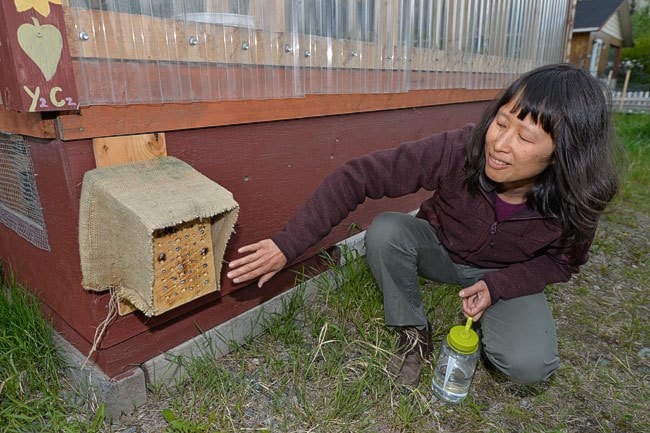Whitehorse’s bumblebees have some new digs, thanks to a study underway by the city.
Maria Leung, a Whitehorse-based biologist, is spearheading the work. She’s aiming to help Ottawa-based researchers better understand the habits of Yukon’s 80 species of bees.
“This began because I went to a pollen workshop at the Kluane Lake Research Station ... it was a gathering of some of the experts on pollination, and I was invited to attend,” Leung said.
“There were a couple researchers there who have been researching bees for many years. They wanted to put together a North-America-wide bee-monitoring network, but one of the challenges of research is funding. Northern places are more expensive,” she said.
So Leung took advantage of a new trend in science that aims to get the public more involved.
“The buzzword now is citizen science, so I thought I could assist in this effort. That’s why I put in the proposal for funding,” she said.
The idea is simple: build boxes for bees to nest in, watch them over the summer, and send samples back to Ottawa in the fall.
The boxes themselves are quite simple. About half of them look like little bird feeders, with a tiny bee-sized hole for a front door and an empty space inside that’s about 10 centimetres cubed.
The space inside is stuffed with upholstery cotton to keep the bees warm. Leung reached out to the Yukon Fish and Game Association to help build the boxes, then recruited people from around the city to take them and install them around the city or on their private property.
“I was quite surprised at how much interest there was in bees,” she said.
The other half of the boxes are wooden blocks with holes drilled in the front of them to serve as tunnels for solitary bees to crawl into and lay their eggs.
It turns out bees are rather fussy homeowners. Finding the right location for a box or block is crucial, Leung said. Otherwise the bees won’t move in.
One of the most important factors is nearby food. But, once a nest is built, if the surrounding flowers later die, the bees will stick with their home and travel farther afield to provision for their colony, she said.
“Most of the bumblebees in the Yukon are ground nesters, though there is one that nests in the cavities in trees. If they think your box is a good place, they’ll move in there,” Leung explained.
With the nest built, bees start gathering pollen and making nectar. After a few weeks, the worker bees hatch. They take over the patrol and foraging duties, while the queen focuses on laying more eggs.
“The second generation is a new crop of queen bees and male drones,” said Leung. “Once those are out, the queen dies that year, along with her workers. What is left at the end of the growing season are the new queens. They’ll find a place underground and they’ll over-winter there.”
The inside of the bee boxes will eventually look like miniature beehives, complete with wax cells and bee larvae.
“With this study the researchers are looking for some baseline information. Who’s using the boxes and what are they feeding on?”
At the end of the growing season, the contents of the boxes will be removed and sent to Ottawa for analysis. Researchers at the University of Ottawa will look at bee carcasses, unhatched larvae and fecal pellets to determine which species of bees are where, what they’re eating and how well their colonies are doing.
“They can also look for pathogens such as parasites,” Leung said.
As far as she knows, there hasn’t been a study like this in the North before.
“Interestingly, there are quite a few western bumblebees here in the Yukon, the ones with the white rumps. They don’t seem to be in trouble here, but they are in other parts of Canada,” she said.
This is the first season that Leung has tried the “citizen science” approach to studying northern bees. If it works, the goal is to run it again over multiple years and establish a baseline of information and start looking for trends and warning signs in the bee populations, she said.
Leung herself got the biology bug when she was a little girl.
“I’m a biologist, I have been for over 25 years. I started when I was a wee person playing around in the dirt, looking at flowers and digging up ant colonies, that sort of thing.
“It’s just a progression for me,” she says, laughing. “I have worked on another charismatic pollinator, the butterfly. I saw this as an opportunity since I am up here in the North already - I understand a bit more how community science can work here, so I tried to help develop the network.”
Contact Jesse Winter at
jessew@yukon-news.com
